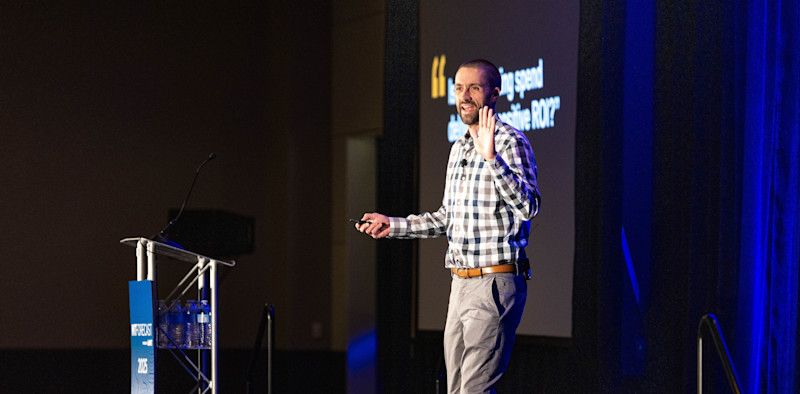In today’s manufacturing landscape, marketers work at the intersection of economic uncertainty, trade disruption, and technological transformation. MTForecast 2025, hosted by AMT – The Association For Manufacturing Technology, brought together industry leaders, economists, and innovators to decode these challenges and chart what success will look like in the year ahead.
For marketers, sessions moved beyond macro trends to offer practical insights into differentiated messaging, customer-centric positioning, and the integration of AI and decision intelligence into marketing strategy.
Top Marketing Takeaways
Differentiate through clarity. Define your ideal customer and build messaging around their problems – not your products.
Focus where it counts. Apply the 80/20 principle: Double down on your top customers and look-alikes to drive profitable growth.
Connect AI to outcomes. Use AI and decision intelligence to optimize lead generation, conversion, and insight, but always tie technology back to measurable business results.
Now is the time to sharpen positioning, embrace AI-driven strategy, and lead the internal conversation on agility and customer-centricity.
For future insights and market outlooks, join AMT’s Winter Economic Forum on January 30, 2026.
The Economic Context: Resilient but Realistic
Experts from Oxford Economics, ITR Economics, the Federal Reserve, NTMA, and AMT highlighted both resilience and headwinds. Global industrial output is projected to grow 2.7% in 2025, slow to 1.9% in 2026, and rebound in 2027. Aerospace and defense remain bright spots; construction benefits from AI-driven infrastructure investment; and agriculture and automotive show signs of recovery in 2026.
For marketers, this means crafting campaigns that balance confidence with candor – acknowledging near-term challenges while positioning for long-term growth.
Positioning, Messaging, and the Power of Focus
Craft Differentiated Messaging for Your Ideal Customer
A core message from Brendon Forrest and Joe Sullivan of Gorilla 76 was clear: Generic messaging no longer works. Marketers must be able to answer, "Can you clearly articulate why your future customers would choose you? And more importantly, can they articulate why?"
Their framework of “ideal customer archaeology” encourages marketers to analyze top customers beyond firmographics, focusing instead on behaviors, mindsets, and collaboration. They suggest using problem storytelling – centering messages on what keeps customers up at night to show how your solutions create transformation.
Specificity and Consistency Win
This framework emphasizes the importance of a specific, targeted understanding of customers. Marketers should define their customers’ main problems precisely, articulate what happens if those problems go unsolved, and identify three clear differentiators with proof points.
Consistency across every touchpoint – from outbound scripts to websites to trade show booths – builds credibility. Advisory boards, customer interviews, and sales-marketing feedback loops keep messaging aligned and validated.
The 80/20 Imperative: Focus Where It Matters Most
For most manufacturers, 20% of customers drive 80% of the revenue. In her session on the 80/20 principle, Mary Kate Phillips of Strategex emphasized strategic focus: Rather than diluting resources, marketers were urged to identify and retain their “whale” customers (the few who deliver outsized value) and build around them.
Key actions:
Use data to identify whales and understand what makes them loyal.
Align sales and marketing strategies for profitability and retention.
Refine segmentation and messaging using market feedback and performance data.
She offered a standout example: A manufacturer adjusted its product literature and lead times to serve OEMs in the data center sector better, then scaled that model to Europe – a proof point for the power of clarity and focus.
AI, Decision Intelligence, and Measuring What Matters
Two MTForecast sessions redefined how marketers should think about technology and measurement.
Dr. Lorien Pratt, CEO of Quantellia, warned that up to 95 % of GenAI projects fail because they are not connected to business outcomes. Her session, “Decision Intelligence: Activating AI, Data, and Human Expertise to Drive Business Outcomes,” introduced a framework for connecting AI tools to decisions that directly affect results.
Her use of causal decision diagrams (CDDs) showed how to visualize ripple effects across departments, helping organizations make smarter investments and faster pivots. For marketers, this means using AI to improve lead generation, conversion, and insight, but always within a framework tied to measurable goals.
Meanwhile, Joe Sullivan’s presentation, “What’s the ROI? Is the Wrong Question,” challenged the obsession with short-term ROI metrics. He notes: “If you’re starting with tactics rather than business outcomes, you’re throwing darts blindfolded and hoping to hit ROI.”
His guidance: Define success in advance, align metrics with the company’s vision, and resist short-term bias. Together, these sessions reinforced the principle that technology and data deliver impact only when grounded in strategic clarity.
Macro Trends and Market Opportunities
Beyond marketing strategy, MTForecast covered emerging opportunities in AI infrastructure, data centers, semiconductors, aerospace, and defense. Presenters also discussed evolving tax and trade policies and their impact on manufacturing investment.
Marketers should align campaigns with these growth sectors, framing their organizations as partners in innovation, not just suppliers. Staying ahead of policy and market shifts allows marketing teams to position their companies as trusted industry guides.
Looking Ahead: Agility, Resilience, and Customer-Centric Growth
Despite expected slowdowns heading into 2026, MTForecast attendees were optimistic. AMT President Doug Woods underscored the promise of AI and digital manufacturing, while economists predicted that any downturn would be short-lived, with a strong recovery anticipated in 2027.
For marketers, the message is clear: Resilience, foresight, and customer-centricity will define the next phase of growth.
Call To Action
Recalibrate your messaging and positioning for the realities of 2026 and beyond.
Leverage AI and data to sharpen your competitive differentiation.
Lead the conversation inside your organization on resilience, agility, and customer focus.
To continue to stay informed on the latest forecasts and outlooks, be sure to join AMT at the Winter Economic Forum on Jan. 30, 2026. And save the date for MTForecast 2026, which will be held on Oct. 14-16, 2026, in Schaumburg, Illinois.






